Back to top page
Front Porch with Cross Gable and Brick Raised Garden
Location
- 1306 Greendale Drive
- Blacksburg, VA.
- USA
Motivation
This documents an addition to the house shown.
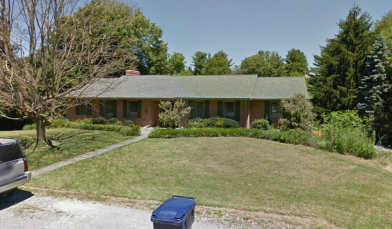 This picture was taken from Google maps, it looks to be from
a year before this project started.
As you can see this is a flat ranch house with a clean look but
very little character like most houses in this neighborhood.
This picture was taken from Google maps, it looks to be from
a year before this project started.
As you can see this is a flat ranch house with a clean look but
very little character like most houses in this neighborhood.
It appears that in around 1976, the original builders of this house
disposed of used bricks in the basement of this house, in a
hidden room, behind a
sheet rock wall in a 10 foot long, by 27 inch wide, by 9 foot
high "crawl space". Sounds crazy, that much space was just
walled off. It's not what you'd call living space, but it has
about 20 square feet of floor space.
We turned this space into a very deep narrow closet.
We managed to clean the mortar off of 825 of the used
bricks for use in this project. We used and other 100 or so broken
bricks as clean fill.
Lightly tapping the hard mortar on the used brick with a small hammer
does the trick.
The used brick is only used as a cosmetic element
in the project, and so does not provide any structural support for
the house or porch.
The finding of the "free" bricks provided the original
inspiration for this project.
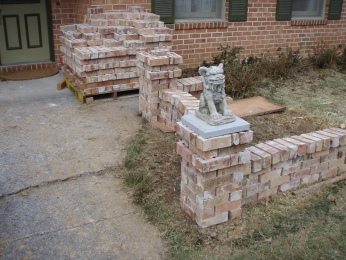 This next image shows what we came up with for a stab at the
garden wall design, just playing around without mortar.
We noticed that the pillar in the rear of the wall looked like
it could be the bottom of a column (post) that holds up a porch roof.
We thought that using the garden wall as an entry way to a
porch would look very nice.
This next image shows what we came up with for a stab at the
garden wall design, just playing around without mortar.
We noticed that the pillar in the rear of the wall looked like
it could be the bottom of a column (post) that holds up a porch roof.
We thought that using the garden wall as an entry way to a
porch would look very nice.
We found if very handy to look at lots of other porches.
Heres some google and bing images of porches:
google porch,
bing porch.
It's good that google has competition.
This next image shows the close to the current state of the project.
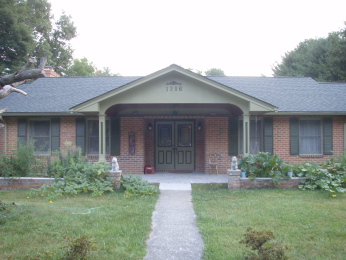 It's pretty much done.
Notice the pair of foo dogs, or are they called Ming lions, have been added to ward off evil
spirits, without which we would be doomed.
Click on an image to see the latest
version of the project image gallery which has more than 500
high res images from when before the project started to
project finish.
It's pretty much done.
Notice the pair of foo dogs, or are they called Ming lions, have been added to ward off evil
spirits, without which we would be doomed.
Click on an image to see the latest
version of the project image gallery which has more than 500
high res images from when before the project started to
project finish.
Materials
The total cost for materials bought was around $3,000.
See the spreadsheet for the full brake down.
- expenses.ods:
This documents all the money expenditures of this project.
The file format is an ODF spreadsheet that is native
to LibreOffice.
- Bricks: 825 siding bricks where found
in the basement of this house.
- Gravel, fill, and top soil:
most existing homes have some of this.
We had additional fill, rocks, used mortar,
broken bricks and concrete,
from past home projects. We broke up an old porcelain toilet,
and sink, and put them under the garden wall footing;
better than putting them in a land fill.
- A dash of luck: To
our surprise, at the time we did this project,
2"x8" lumber was cheaper than 2"x6" lumber, in
all the lengths that we wanted, so we opted to use 2"x8"
framing timbers, where-by saving money and making a
sturdier porch. Note: using 2"x6" rafters and ceiling
joists would require some design modifications to what we did,
but not much.
Software Tools Used
We use a GNU/Linux OS, but if you have not gotten wise yet,
we hear this all works on Windows too.
- Vim: was
used to edit this web page.
- LibreOffice
for the spreadsheet above.
- Blender was used to make a
3D digital model:
porch.blend is a
native blender model file.
This model is not complete, but it shows most of the framing.
- dia was used to add
text and arrows to bender renderings.
We could have used LibreOffice, or lots of other programs to
do this, but dia is a smaller and therefore quicker program
to run and learn how to use.
Here are some links to
model renderings:




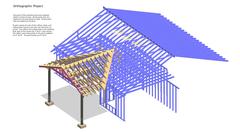
Rant: As you can see it's kind of like a gable dormer, but too large and with no side walls;
and it's kind of like a cross gable but the crossing gable is much smaller than
the existing gables; and so this is not a pure cross gable. This lack of symmetry
in the height of the crossing roof ridges could make a regular cross gable unstable, not
to mention more difficult to frame when most of the roof is already shingled.
Since we do not expect to get any useful living space in the area in the roof attic
the solution is easy, just brace the new roof through to the bearing walls that
just happen to be there already. Those little 2 by 4 braces that are added to
the old roof are very important, we'd guess they increase the load bearing capacity by at
least 5 times as without them, likely much more.
The braces are transferring load directly to the
bearing walls. Without the braces the load is carried by the
existing rafters midway in their span. That's just obviously
a bad thing.
It may be over-kill, but it's cheap and easy to do.
In my experience, most builders do not consider such things; many builders
do not even understand what
joist bridging
is for, and exclude it in their projects.
To my disapproval, half the companies (3/6) I worked for never installed joist
bridging in their floors in their residential house
construction, even then joist spans where over twelve feet.
By just about any reasonable measure standard joist bridging will at
least double the load-bearing capacity of a floor.
Getting a Blacksburg Building Permit
The Blacksburg site page Building
Review and Permitting has the telephone to call
to get you started in getting your permit.
The people who run the Blacksburg Building
Review and Permitting office do not maintain their own web pages
themselves, so don't count on everything being up to date on
that part of the Blacksburg.gov site.
Here's
a link to Blacksburg permit forms that they have on the site.
Rant: We find it a little disturbing that all the Blacksburg.gov web page
URLs only vary by the query part of the path, just a page number.
Will these blacksburg.gov links brake when web pages are added or removed?
Could be a lack of foresight, or lack of understanding of what hyperlinks
are, etc.
We got our permit by submitting the following papers:
- Building
Permit Application form: We had to call the telephone number
on the form in order to fill out the obscure code symbols that were on
the form. The form is far from self explanatory.
- A photo copy of the property
plat
which we got when we bought the house.
On this plat we drew an outline of the house porch addition,
just one rectangle.
- A printout of the following drawings (repeated from above).
You may need additional forms if you are hiring a contractor(s) other than yourself.
The enforcement of building standards has changed drastically since most of
the houses in Blacksburg were built.
We passed the rough inspection on June 19, 2013 and the final inspection
on October 11, 2013 with no issues in either inspection.
The finishing of the brick garden bed, post casings, and deck where
not required for the final inspection, given that the permit was
only required for the porch roof, trim, ceiling and supporting posts.
The posts did not require decorative casings to pass final inspection.
We added the pretty post casings after the brick garden beds were
built after all inspections. The deck was the last major part of the project that was
finished on about July 4, 2014. Clearly this was a spare time
project with only one person doing the work.
Update: 2015-Jan-06 I've been inspired by a floor tile mosaic
that I saw at the Roanoke Old
Southwest Parlor Tour
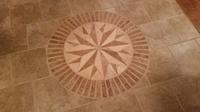
References
You may find the following links useful:
 This picture was taken from Google maps, it looks to be from
a year before this project started.
As you can see this is a flat ranch house with a clean look but
very little character like most houses in this neighborhood.
This picture was taken from Google maps, it looks to be from
a year before this project started.
As you can see this is a flat ranch house with a clean look but
very little character like most houses in this neighborhood.







